At City Hall Wednesday morning, the Historic Preservation Commission decided to allow a public hearing for the possible preservation of the AMVETS building. The public hearing will be held at a Special Meeting on Wednesday, November 12.
Category Archives: History
AMVETS building preservation app deserves public hearing
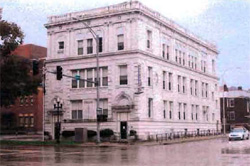 Thanks to the kindness of City staff members in the City Clerk and Planning & Growth departments, I was able to get a copy of the historic preservation application for the AMVETS building:
Thanks to the kindness of City staff members in the City Clerk and Planning & Growth departments, I was able to get a copy of the historic preservation application for the AMVETS building:
![]() Historic Preservation Application for 237 NE Monroe (3.03 MB)
Historic Preservation Application for 237 NE Monroe (3.03 MB)
The applicant, Les Kenyon on behalf of the Central Illinois Landmarks Foundation, makes a compelling case for preserving this building, originally known as the United Duroc Building. Here is a summary of his argument from the application:
Built and dedicated in 1916, the United Duroc Bldg. is a Colonial Revival style with significant architectural features that meet criteria #4 and #6. Features include white enamel (glazed) brick and glazed terra cotta; there are elaborate decorative crowns above the dual entrances, fanlight-transom windows, terra cotta cornices, trabeated pilasters with triglyphs and gutta, Palladian windows.
Designed by WH Reeves and built by WM Allen, two key men involved in the design and construction of Peoria’s most notable buildings including Peoria’s City Hall, Spalding Institute, Glen Oak Park Pavilion, St. Augustine Manor, Peoria State Hospital, Mohammed Temple and many others.
The United Duroc building was also home to: the distinguished University Club, Battle Creek Baths and a Comptometer School and publishing company.
The application states that this building meets five out of the nine criteria for historic preservation:
- #3 — Its identification with a person who significantly contributed to the development of the City, State or Nation.
- #4 — Its embodiment of distinguishing characteristics of an architectural style valuable for the study of a period, type, method of construction or use of indigenous materials.
- #5 — Its identification as the work of a Master Building Designer, architect or landscape architect whose individual work has influenced the development of the city, the state or the nation.
- #6 — Its embodiment of elements of design, detailing, or craftsmanship that render it architecturally significant.
- #8 — Its unique location or singular physical characteristics that make it an established or familiar visual feature.
You can read all the details in the application.
I called Les Kenyon today to ask him a couple of questions that came up in my last post. He was kind enough to take my call. I asked him why he hadn’t applied for historic preservation of this building until now — why not anytime in the last 40 years, as some have suggested. He replied that, first of all, the property didn’t come up for sale until just recently, and secondly, there wasn’t an historic preservation ordinance 40 years ago. He said we didn’t get such an ordinance until “5 or 6 years ago.” (Actually, I checked, and the city’s historic preservation ordinance was passed August 15, 1989 — about 19 years ago. Time flies.) He said prior to that time, if you wanted to preserve a building, you had to buy and save it yourself.
I asked him if he and the Central Illinois Landmark Foundation had any plans to be more proactive in requesting historic status for other buildings instead of waiting until they come up for sale or demolition. He said yes, that in fact one of the CILF board members has a list of several historic properties that they are planning to go over at a future meeting and ultimately present to the city council. However, he said they have to be careful about presenting too big of a list because it may alarm some council members who aren’t supporters of historic preservation. He feels it’s more effective to take small steps toward preservation.
And that strategy perhaps best explains why some requests for preservation come at the 11th hour. It’s not that these weren’t worthy buildings in the first place. It’s simply that they are strategic in submitting applications, and sometimes a building that’s on their list comes up for sale or demolition before they’ve gotten to it. Then they have to move it to the top of the list.
Whether or not you think the building should ultimately be preserved, I believe it at least deserves a hearing. I know this will cause some delay of AMVETS’ plans, and that’s regrettable. But once a historic structure is gone, it’s gone forever. I think it’s worth our time (and for a public hearing, we’re talking about less than 45 days) to make sure we’re not going to regret its demolition after it’s too late to do anything about it. Let’s make sure this application is fully vetted, and if the building does not warrant salvaging, so be it.
The Historic Preservation Commission will decide Wednesday morning at their regular meeting, 8:30 a.m. in City Hall Room 400, whether to grant a hearing or not.
Will AMVETS historic preservation request get a hearing?
 I reported recently on some historic preservation requests that are wending their way through the system. One of those is the AMVETS building, 237 NE Monroe. That building got some criticism in the comments section of my blog. And according to another reader who e-mailed me over the weekend, there’s an effort underway to kill the proposed historic designation without even so much as a hearing:
I reported recently on some historic preservation requests that are wending their way through the system. One of those is the AMVETS building, 237 NE Monroe. That building got some criticism in the comments section of my blog. And according to another reader who e-mailed me over the weekend, there’s an effort underway to kill the proposed historic designation without even so much as a hearing:
Dear Sir
I saw your article about preserving the AMVETS building and wanted to inform you of the following: This upcoming Wednesday the Historic Preservation Commission (HPC) will decide if the AMVETS application will receive a public hearing. I am afraid that they are being swayed, for the wrong reasons, to vote against a public hearing.
The building’s application, which can be obtained from the city, to make it historical was put together very well. There are nine criteria to make a building historic and only one of the nine needs to be met to make a designation. The application cites that the building meets 4 of the nine criteria and lists details why, providing pictures and proper research.
Key (although not all) members within the AMVETS do not want this to happen because they are in the process of trying to move the post location and a historic landmark of the building could prevent this. Certain AMVETS officers of the corporation are not sharing this information with the organization’s membership and lobbying the HPC to vote it down on Wednesday.
The point I am trying to make is that the Historic Preservation Commission has an obligation to permit a public hearing on applications that have merit. This building obviously has merit and deserves a public hearing. This will not guarantee the building is land-marked but will ensure its case is heard, as it should be. The buyer of AMVETS has made its intentions clear to eventual raze the building and it would be a shame to see a possible historic landmark torn down without a public hearing.
I request you make this known so that the commission feels pressure to do their job of ensuring applications get a fair public hearing. You may email me with questions and I understand if you do not want to get involved.
Thank you
A concerned citizen and veteran
I still haven’t seen the application, but it does seem reasonable to have a public hearing if the building indeed meets four of the nine criteria for historic designation. It’s not listed on the October agenda published on the city’s website, but this week’s “Issues Update” confirms, “The Historic Preservation Commission will be conducting a preliminary review of an application to Landmark property at 237 NE Monroe on October 22, 2008 instead of November 26, 2008.”
The Historic Preservation Commission meets at 8:30 a.m. this Wednesday.
More historic landmark applications a good thing… mostly
According to this week’s “Issues Update” from the City, historic landmark applications in Peoria are up.
“In the past two years, 2007 and 2006,” the report states, “a total of two landmark applications were filed for Irving School and Glen Oak Park.” In 2008, however, there have been four: Amvets Post #64 (237 NE Monroe), Hamilton Boulevard, 401 NE Monroe, and Family House Peoria (1509 N. Knoxville).
For those of you who can’t picture these buildings, here they are — respectively, the Amvets building, Family House, and 401 NE Monroe:
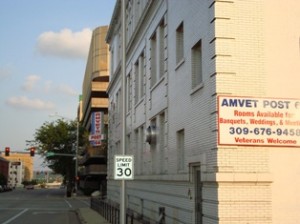
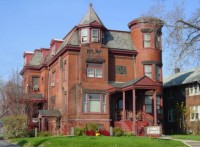
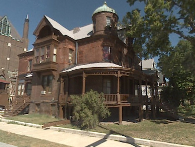
Generally, I see this as a good thing. Too much of Peoria’s history has already been razed. What’s left really should be preserved — presuming, of course, that it meets reasonable standards for preservation. Most of these properties do.
The one exception would be Hamilton Boulevard. This is on the council’s agenda for Tuesday night. What they are actually proposing be given landmark status is “the built median component of the right-of-way, located within Hamilton Boulevard, from Monroe Street to Glendale Avenue, and Randolph Avenue to North Street.” To which I ask, The median? Really?
The justification for this appears to be the fact that the street was laid out by William S. Hamilton, son of Alexander Hamilton (you remember Alexander Hamilton — the guy on the $10 bill, first Secretary of the Treasury, died after famous duel with Aaron Burr). Okay, sure, William Hamilton is a prominent historical figure in Peoria. But he also laid out Water, Washington, Adams, Jefferson, Madison, Monroe, Liberty, Main, and Fayette. Should we also landmark all of those streets?
Besides, they kind of undercut their whole preservation argument when they removed the portion of Hamilton that is slated to be changed for the Methodist Hospital expansion. Les Kenyon of the Central Illinois Landmark Foundation (CILF) is quoted in the Historic Preservation minutes as saying:
…they [CILF] are satisfied that Methodist Hospital will provide a beautiful environment for patients, medical staff and visitors as they travel on the Hamilton corridor. He went on to say that for this reason, they have amended their original position with regard to Methodist Hospital’s plans and withdraw any objection to the Methodist Plan regarding landmarking Hamilton Boulevard through the Methodist campus and want to remove the Methodist campus from their landmark request.
But Methodist Hospital is removing the built median that CILF wants to see landmarked on the rest of the boulevard. So, is it historic or not? And Methodist is narrowing Hamilton where it passes their institutional zone. So, is the width of the street worth preserving or isn’t it? If Methodist’s plans for Hamilton don’t destroy the historic nature of the boulevard, then nothing does, and thus it needn’t be landmarked.
But don’t get me wrong. Even though I question this one landmark request, overall I think preserving Peoria’s built history is important. I was recently reading some newspaper clippings about the razing of the Rialto Theater to make way for the Civic Center, and it made me sad. It was one of Peoria’s original vaudeville houses. Originally called the Hippodrome, it housed many famous acts, as did the Palace Theater which was also razed about the same time. Whereas other cities, like Chicago, preserve their historic theaters, Peoria tore theirs down and felt the Civic Center theater was an adequate replacement. What a shame.
I’ve often joked (morbidly) that any history museum in Peoria should include an interactive exhibit where visitors can sit in a little crane and swing a wrecking ball into models of Peoria’s historical landmarks. It would be an object lesson in how little we value our history.
Descriptive Sketch of Peoria, 1896
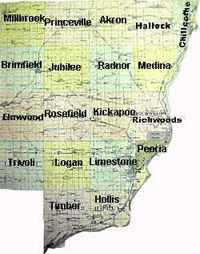 As I was reading PeoriaIllinoisan’s transcription from a 1908 book about Peoria, it reminded me of some of the descriptions I’ve read in a book I inherited from my grandfather: “Standard Atlas of Peoria City and County Illinois” by M. Huebinger, C. E., Peoria, Ill., published by Geo. A. Ogle & Co. Publishers & Engravers, 1896. So, today’s post will be just a little slice of Peoria history.
As I was reading PeoriaIllinoisan’s transcription from a 1908 book about Peoria, it reminded me of some of the descriptions I’ve read in a book I inherited from my grandfather: “Standard Atlas of Peoria City and County Illinois” by M. Huebinger, C. E., Peoria, Ill., published by Geo. A. Ogle & Co. Publishers & Engravers, 1896. So, today’s post will be just a little slice of Peoria history.
The city was quite a bit smaller then. I don’t have a good way of scanning the map, so I’ll just describe the city limits. At the northeast, the city goes no further north than Nebraska Ave. — that means that Glen Oak Park and Springdale Cemetery are not in the city. Moving west, the city line goes south at Knoxville, then west on Illinois to Elizabeth (now Sheridan). Then the city line goes south again along Elizabeth to Chambers Ave. (now Columbia Terrace). The line then extends west along Chambers to Bradley St. (now University), where it goes south to Main, then west on Main to Western Ave. Are you with me so far? You may have noticed that Bradley Park is also not in the city limits, nor is the Bradley Farm which would become the Uplands neighborhood six short years after this atlas was published.
The city line then goes south along Western to Lincoln Ave., west on Lincoln to a point in line with Livingston St., then south through the middle of several blocks and along Livingston to Grinnell. It dances back to Western (too hard to explain), then heads south to “Lower Main” (now Krause Ave.), then straight east to the river. And that’s it. That’s all there was to the city.
There was a part of Richwoods township called “North Peoria,” which was roughly a rectangle from modern-day Sheridan and Wilcox at the northwest to Nebraska and Perry to the southeast. There was also a part of Peoria township called “South Peoria” that was roughly anything south of Seventh St. (now Martin Luther King Jr. Dr.) and west of Western (except those areas I said earlier were within Peoria). Everything else was unincorporated.
As you read this glowing description of Peoria from the 1896 Peoria Atlas, you’ll have to suffer the flowery, verbose way of writing that was popular then. But pay close attention to the description of the schools, parks, and streets, and the new library they were building — this would be the “model of architecture” that was torn down in 1968 to make way for the non-descript box we have now.
Now, without any further ado, here’s the “Descriptive Sketch of Peoria from 1896:
